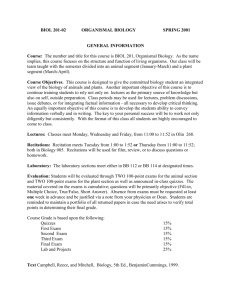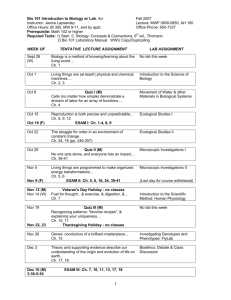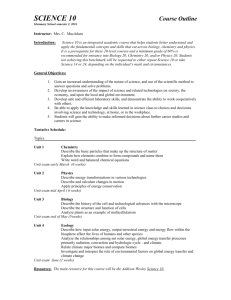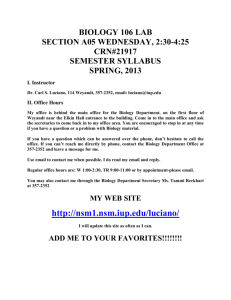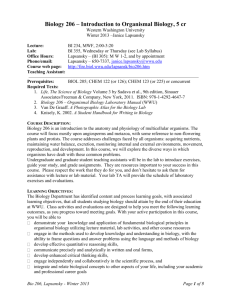Biology 206 – Introduction to Organismal Biology
advertisement
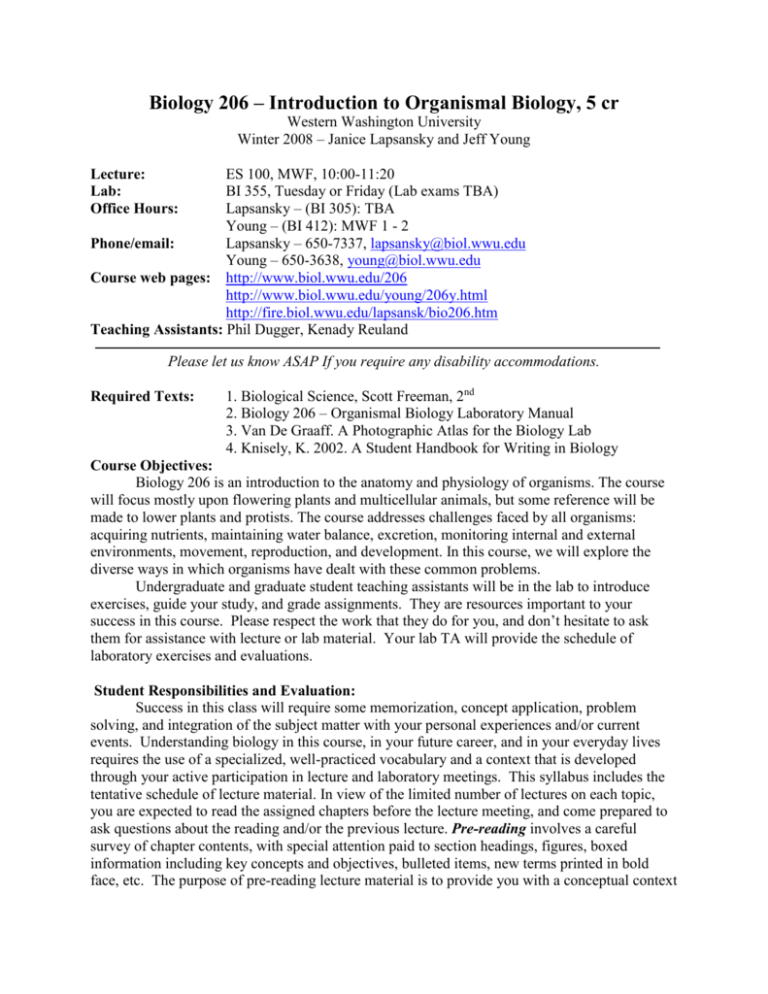
Biology 206 – Introduction to Organismal Biology, 5 cr Western Washington University Winter 2008 – Janice Lapsansky and Jeff Young Lecture: Lab: Office Hours: ES 100, MWF, 10:00-11:20 BI 355, Tuesday or Friday (Lab exams TBA) Lapsansky – (BI 305): TBA Young – (BI 412): MWF 1 - 2 Phone/email: Lapsansky – 650-7337, lapsansky@biol.wwu.edu Young – 650-3638, young@biol.wwu.edu Course web pages: http://www.biol.wwu.edu/206 http://www.biol.wwu.edu/young/206y.html http://fire.biol.wwu.edu/lapsansk/bio206.htm Teaching Assistants: Phil Dugger, Kenady Reuland Please let us know ASAP If you require any disability accommodations. Required Texts: 1. Biological Science, Scott Freeman, 2nd 2. Biology 206 – Organismal Biology Laboratory Manual 3. Van De Graaff. A Photographic Atlas for the Biology Lab 4. Knisely, K. 2002. A Student Handbook for Writing in Biology Course Objectives: Biology 206 is an introduction to the anatomy and physiology of organisms. The course will focus mostly upon flowering plants and multicellular animals, but some reference will be made to lower plants and protists. The course addresses challenges faced by all organisms: acquiring nutrients, maintaining water balance, excretion, monitoring internal and external environments, movement, reproduction, and development. In this course, we will explore the diverse ways in which organisms have dealt with these common problems. Undergraduate and graduate student teaching assistants will be in the lab to introduce exercises, guide your study, and grade assignments. They are resources important to your success in this course. Please respect the work that they do for you, and don’t hesitate to ask them for assistance with lecture or lab material. Your lab TA will provide the schedule of laboratory exercises and evaluations. Student Responsibilities and Evaluation: Success in this class will require some memorization, concept application, problem solving, and integration of the subject matter with your personal experiences and/or current events. Understanding biology in this course, in your future career, and in your everyday lives requires the use of a specialized, well-practiced vocabulary and a context that is developed through your active participation in lecture and laboratory meetings. This syllabus includes the tentative schedule of lecture material. In view of the limited number of lectures on each topic, you are expected to read the assigned chapters before the lecture meeting, and come prepared to ask questions about the reading and/or the previous lecture. Pre-reading involves a careful survey of chapter contents, with special attention paid to section headings, figures, boxed information including key concepts and objectives, bulleted items, new terms printed in bold face, etc. The purpose of pre-reading lecture material is to provide you with a conceptual context and an introduction to the vocabulary so that you may actively participate in lecture. Similarly, you are required to read the laboratory assignment prior to your arrival in the lab, and in doing so, be ready to learn. In many cases, the course of lecture and lab discussions will assume that you are familiar enough with the topic for us to emphasize material that may be more difficult to comprehend or that will go beyond what is covered in the textbook or lab manual. Investments of time and energy in this way will increase the chance that the course will not only meet your expectations, but that you will also be satisfied with your performance. Grades will be assigned on the basis of your performance on frequent quizzes and two exams in each of the two portions of the course (animal biology and plant biology), and your laboratory work, as follows: Lecture exams (4) 100 points each 400 points total 73% Lecture quizzes (variable) 40 points total Laboratory exams (2) 60 points each 120 points total 27% Laboratory worksheets and reports: (variable) 40 points total 600 points possible Lecture exams and quizzes will consist of a mixture of multiple choice, fill-in, matching, concept mapping, and short essay questions. Quizzes may be taken with a partner. Enrollment Policy: You are currently enrolled in this course and only you can change this. If you fail to complete all of the assignments, or stop coming to class and do not fill out an official withdrawal, you will receive a failing grade. This policy is in place due to the fact that demand for this class often exceeds space availability and to facilitate responsible and timely decisions regarding enrollment. Missed Exam and Late Work Policy: It is the student’s responsibility to make it to all exams/quizzes. Makeup exams will be given ONLY if you are excused from the exam BEFORE the scheduled date, or, in the event of illness, you have a note from a health professional confirming that you were unable to take the exam during the scheduled time. (Contact me directly or leave a message in the Biology office.) It is also your responsibility to contact me as soon as you return. Failure to do so may jeopardize your chance of a make-up exam. Make-up exams are usually all essays. Late assignments are usually penalized 10% for each day late. Grading Scale: 94 - 100 % A 90 - 93 A87 - 89 B+ 84 - 86 B 80 - 83 B77 - 79 C+ 74 - 76 70 - 73 67 - 69 64 - 66 60 - 63 below 60 % C CD+ D DF Students who choose P/F as a grading option must achieve at least 74% to pass. Tentative Lecture Schedule: Biology of Plants Young Winter 2008 Day Lecture Topics W 1/9 F 1/11 Week 1: 1/14 – 1/18 M W F Week 2: 1/21–1/25 M W F 1/25 Week 3: 1/28 – 2/1 M W F Week 4: 2/4 - 2/8 M W F Week 5: 2/11 – 2/15 M 2/11 Introduction Plant Structure and Growth I Plant Structure and Growth II Assigned Readings Chapter: pages JY and JL Ch 35: 804 - 811 Ch 35: 811 – 818 Plant Structure and Growth III Ch 35: 811 – 827 Transport in Plants I Ch 36: 828 – 834, Quiz Transport in Plants II Ch 36: 834 – 842 Martin Lurther King Jr. Day Transport in Plants III EXAM I Ch 36: 842 – 851, Quiz Lectures 1 – 7, Chs 35 and Plant Nutrition I Plant Nutrition II Plant Reproduction I 36Ch 37: 852 – 863 Ch 37: 863 – 870 Ch 40: 910 - 919; 478-481 Plant Reproduction II Plant Response to Signals I Plant Response to Signals II Ch 40: 919 - 931 Ch 39: 888 – 909, Quiz Ch 38: 871 - 882 Lectures 8 - 13, Focus on Chs 37, 38, 39, 40; though comprehensive 2/13/08 Biology of Animals : EXAM II Lecture notes and reading assignments are subject to change. (Note: last day for late course withdrawal - for students with withdrawal privileges - is Friday, Feb 22nd) Tentative Lecture Schedule: Biology of Animals Lapsansky - Winter 2008 Topics: Animal Form and Function Introduction to Animal Homeostasis Animal Nutrition Circulation in Animals Gas Exchange in Animals Osmoregulation and Excretion Chemical Signals in Animals Nervous Systems Sensory Systems Movement and Locomotion Assignments To Be Announced.
